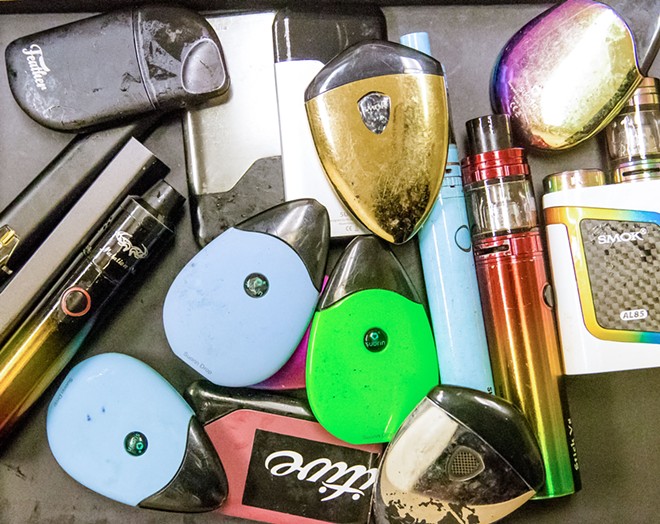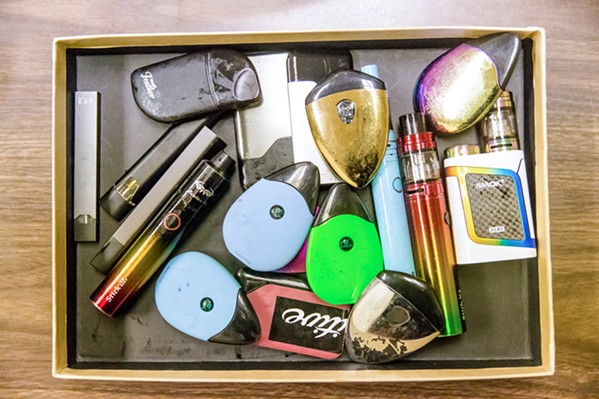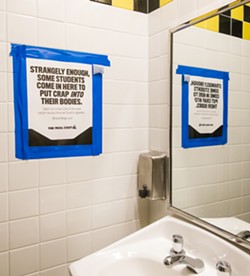Subtle inhalation: Tobacco prevention specialists are worried electronic cigarettes are addicting a new generation
By Camillia Lanham and Kasey Bubnash[{
"name": "Ad - Medium Rectangle CC01 - 300x250",
"id": "AdMediumRectangleCC01300x250",
"class": "inlineCenter",
"insertPoint": "8",
"component": "2963441",
"requiredCountToDisplay": "12"
},{
"name": "Ad - Medium Rectangle LC01 - 300x250",
"id": "AdMediumRectangleCC01300x250",
"class": "inlineCenter",
"insertPoint": "18",
"component": "2963441",
"requiredCountToDisplay": "22"
},{
"name": "Ad - Medium Rectangle LC09 - 300x250",
"id": "AdMediumRectangleLC09300x250",
"class": "inlineCenter",
"insertPoint": "28",
"component": "3252660",
"requiredCountToDisplay": "32"
}]
The campaign against tobacco over the last several decades has worked. Messaging built into the public school system's health classes successfully got the message across: Cigarettes are gross. Cigarettes cause cancer.
These are phrases that San Luis Obispo High School Principal Leslie O'Connor said he hears from his students. So when O'Connor sits down with a student who's been caught with an electronic cigarette, a vape pen, or a pod mod, he always questions them about traditional tobacco use.
"I ask them if they would smoke a cigarette, and they say, 'No that's disgusting,' while I'm sitting there holding their vape pen," O'Connor said. "They think it's clean. ... The messaging from these companies is so proactive and so subtle."
The act of vaping is also subtle. Vapes and e-cigarettes work on essentially the same premise as old-fashioned rolled cigarettes—delivering nicotine quickly to the body through inhalation—but without the tobacco and smelly smoke that comes with it. Pods hold a liquid called e-juice that gets heated into vapor that users can then inhale.
"The products are almost impossible to detect because they look like USBs, they look like pens. They just look like something you'd have lying around in your backpack," O'Connor said.
The school has really seen an increase in use over the last 18 months, O'Connor said. And that use isn't limited to high school students. It's also occurring on other campuses, San Luis Coastal Unified School District Superintendent Eric Prater said, and in middle school. Prater said if you ask a class full of ninth graders if they vape or know of anyone who does, almost every hand in the classroom shoots up.
According to the 2018 California Healthy Kids Survey, 41 percent of 11th graders in the district had ever tried e-cigarettes, 28 percent used them currently, 29 percent had used them four or more times, and 9 percent used them daily. Prater thinks the actual numbers are higher than that. He said students he's spoken with have said they believe the percentage of students who have tried e-cigarettes or use them somewhat regularly is much higher as well.
"Four or more times could easily translate into, 'I'm doing this right now,'" Prater said, adding that at Morro Bay High School at least 500 students out of the 2,300 to 2,400 students at the school are vaping.
"And that's what we know of," Prater said. "That's a lot of kids."
The issue isn't isolated to San Luis Coastal, although the numbers do vary in school districts across the county. Coast Unified School District has the lowest number of vapers in the county, according to the 2018 California Healthy Kids Survey data, with 13 percent of 11th graders reporting that they have vaped four or more times. Shandon Unified School District has the highest, with 38 percent of 11th graders and 6 percent of seventh graders reporting that they've vaped four or more times.
Although modern vapes and e-cigarettes have existed for more than a decade, improved technology, a wider range of flavors (about 7,000-plus flavors, according to Prater), and increasingly sleek devices have made vaping popular among teens in recent years. It's become so common that the Food and Drug Administration (FDA) said in a September 2018 press release that the trend had reached "an epidemic proportion," and announced a major enforcement operation aimed at reducing sales of e-cigarettes to minors.
While some say vapes simply provide a safer alternative to the deadly carcinogens and tar that come with burning tobacco, tobacco use prevention specialists worry that the devices are getting a new generation addicted to nicotine, unraveling decades of prevention work on the federal, state, and local levels.
"It worries me, and quite frankly I see corporate manipulation," Prater said. "It's very clever and it's been marketed to take advantage of our youth. I'm not only concerned. I'm upset about it."
'It's not cuul to JUUL in schuul'
Until only recently, Lompoc resident Mustafa Fhaies smoked two packs of cigarettes nearly every day. Eventually he grew tired of the most common side effects of smoking—his hair and clothes constantly reeked of tobacco smoke, he struggled to sleep, and he suffered lengthy and intense coughing fits almost every morning.
He switched to vaping JUULs, a still relatively new but extremely popular brand of e-cigarette, and Fhaies said the severity of his symptoms soon diminished. They haven't returned.
"I feel way better," he said. "Now I can't even stand the smell of cigarettes."
So Fhaies said he can see why vapes in general, and especially JUULs, are such hot ticket items at each of his four tobacco and vape shops in Lompoc, Santa Maria, San Luis Obispo, and Santa Cruz County.
Fhaies said that while his tobacco sales have dropped off in recent years, vape and e-cigarette sales are only increasing. His vape-related sales nearly doubled in 2018, and he said JUUL is one of his best sellers.
While the advent of vape culture has been great for his bottom line, Fhaies said he has to be careful.
"We get a lot of minors trying to buy," he said. "A lot. Especially in San Luis and Santa Maria."
Other sellers aren't as careful as Fhaies. Inger Appanaitis, SLO County's Tobacco Control Program manager, said that 12 percent of the licensed tobacco retailers in the incorporated areas of the county violated rules regulating age requirements for the sale of tobacco in 2018.
E-cigarette use rose significantly among U.S. middle and high school students between 2011 and 2017, according to data collected by the Truth Initiative. While only 1.5 percent of high school and 0.6 percent of middle school students reported using e-cigarettes in a 2011 National Youth Tobacco Survey, 11.7 percent of high school and 3.3 percent of middle school students reported using e-cigarettes in 2017.
The 2018 National Youth Tobacco Survey shows an even more dramatic situation. The number of U.S. high school students who reported being current e-cigarette users increased by 78 percent between 2017 and 2018. Numbers among middle school students rose by 48 percent.
"All the progress we've made in decreasing tobacco use over the last 20 or 30 years with traditional tobacco products has basically been negated with e-cigarettes," Appanaitis said. "Students don't really understand, 1, what nicotine is, and, 2, how addictive it is."
Health officials are just now starting to understand the depth of the situation and looking at the health effects of electronic tobacco products. Appanaitis said that schools, parents, local governments, and law enforcement are struggling to catch up with how fast vaping devices have proliferated into youth culture. The health department is doing things such as holding health education workshops with adults and working with some schools on a case-by-case basis to educate teachers and students. Schools are trying to figure out the best way to supplement the curriculum they already use for traditional tobacco products to include the new technology.
"School curriculums have been developed over decades to talk about the traditional dangers of tobacco smoke," she said. "It's our jobs to know about these devices, and we're still trying to catch up with how quickly these devices have come on."
Catching up
It's an issue parents, teachers, and law enforcement agencies across the nation are working to address, and a pattern many feel is no accident.
With wide ranging fruity flavors sold in brightly colored boxes, youth-centered ads on social media, and easy-to-hide techy designs, e-cigarette manufacturers have been widely accused of purposely targeting teens.
After the FDA announced its plans to tighten restrictions on e-cigarette manufacturers in September, the agency gave companies like JUUL, Blu, and Logic 60 days to develop plans to keep their products away from teens.
On Nov. 13, JUUL announced it would stop selling most of its flavored e-juice pods in stores and discontinue its social media promotions. Two days later, the FDA announced plans to officially ban most e-cigarette flavors, flavored cigars, and menthol cigarettes.
"JUUL Labs shares a common goal with the Surgeon General and other federal health regulators—preventing youth from initiating on nicotine," a company spokesperson said in an emailed statement to New Times. "We are committed to preventing youth access of JUUL products. ... As we said before, our intent was never to have youth use JUUL products. We have taken dramatic action to contribute to solve this problem."
On Nov. 15, FDA Commissioner Scott Gottlieb announced new rules aimed at curbing teen use of e-cigarettes, including age restrictions on stores that can sell flavored e-cigarette products as well as the way those products are advertised. In December, Assemblymember Jordan Cunningham (R-SLO) introduced a bill into the state Legislature that would limit the way that e-cigarette manufacturers are allowed to advertise their products. Although it's similar to the FDA's proposed regulations, Cunningham said there is no guarantee that those rules will become law anytime soon or that they will survive legal challenges.
The bill would ban e-cigarette and e-juice marketing toward children and make it illegal for manufacturers to package products in a way that is appealing to youth, and it's modeled after similar regulations the tobacco and cannabis industries already adhere to. Features like cartoons, bright colors, and candy-themed flavors would no longer be allowed in e-cig ads or on packages.
"There is a need for California to lead the way and set our own standards through democratically elected legislation rather than bureaucratic mandate," Cunningham said in an emailed response to questions. "Locally, teachers, parents, and even my own middle-school aged kids have told me that more and more kids are using these products. For the long-term health of our children, it's absolutely critical that California lead the way and prohibit these e-cigarette companies from overtly marketing their products to kids." Δ
Reach editor Camillia Lanham at [email protected].
Speaking of Health And Beauty 2019
Latest in News
Readers also liked…
-

Coast Unified teachers upset over new position's salary and qualifications
Oct 20, 2022 -

SLO police identify alleged driver who hit and killed couple
Dec 22, 2022 -

When the levee breaks: Oceano residents, county officials walk a tightrope of regulations to manage Arroyo Grande Creek, which some say led to the levee's failure in January
May 18, 2023
















